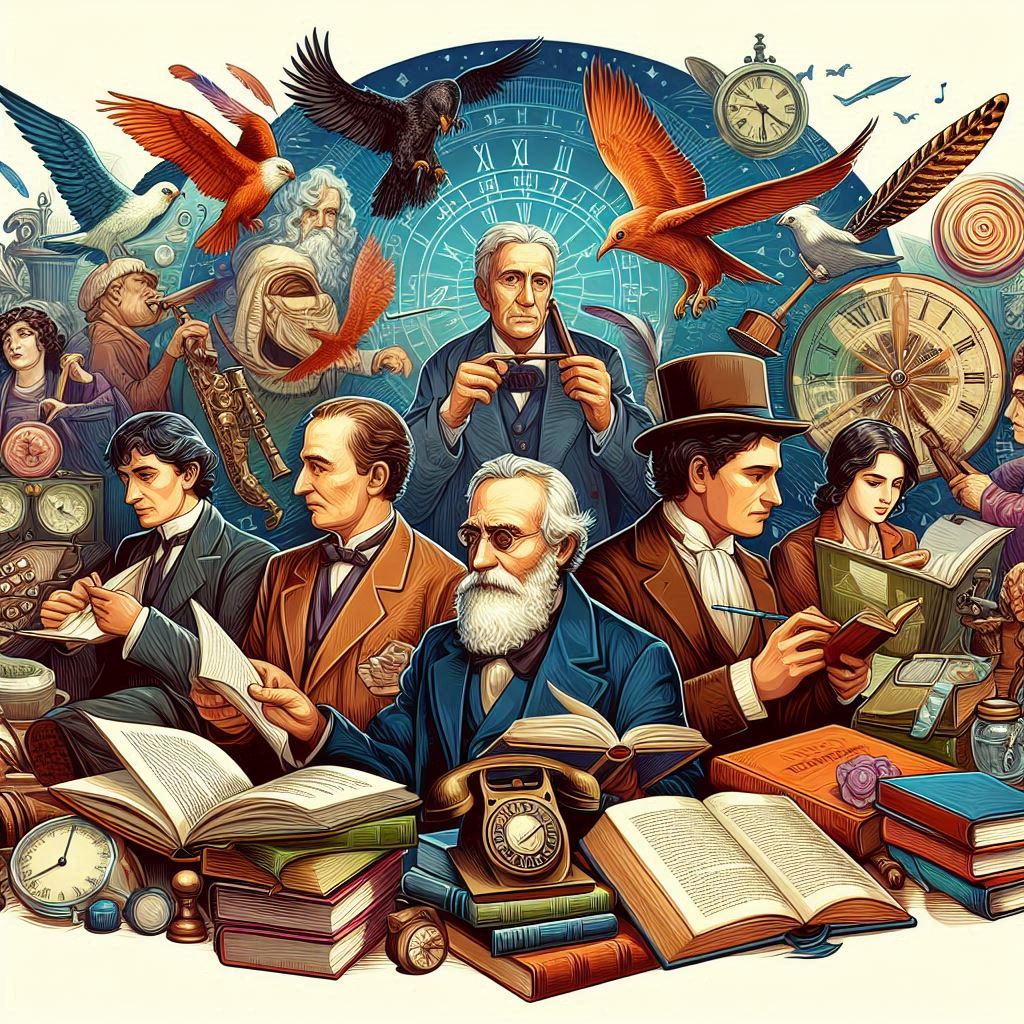Introduction
Throughout history, certain authors have left an indelible mark on literature, influencing generations of readers and writers alike. Their works transcend time and place, offering profound insights into the human condition. This article delves into the lives of these famous authors and examines their most influential works, exploring how they have shaped the literary landscape.
William Shakespeare: The Bard of Avon
William Shakespeare is often hailed as the greatest playwright and poet in the English language. His works have been translated into every major living language and performed more often than those of any other playwright. Shakespeare’s influence on literature is unparalleled, with his exploration of human nature and mastery of the English language setting the standard for writers worldwide.
“Hamlet”
“Hamlet” is arguably Shakespeare’s most famous play, known for its complex characters, intricate plot, and deep philosophical themes. The play explores themes of revenge, madness, and the nature of existence, with the character of Hamlet providing one of the most profound examinations of the human psyche in literature.
“Romeo and Juliet”
“Romeo and Juliet” is a timeless tragedy about young love and family feud. The play’s exploration of intense emotion and conflict has made it one of the most enduring works in literary history, frequently adapted into various forms of art and media.
Jane Austen: The Pioneer of Romantic Fiction
Jane Austen’s novels are celebrated for their wit, social commentary, and keen observations of early 19th-century English society. Her works often focus on the lives and loves of the British landed gentry, with a particular emphasis on the role of women and marriage.
“Pride and Prejudice”
“Pride and Prejudice” is Austen’s most beloved novel, chronicling the turbulent relationship between Elizabeth Bennet and Mr. Darcy. The novel’s sharp critique of social class and gender expectations, combined with its engaging plot and memorable characters, has cemented its place as a classic of English literature.
“Sense and Sensibility”
“Sense and Sensibility” explores the lives of the Dashwood sisters, Elinor and Marianne, as they navigate love, loss, and financial uncertainty. The novel contrasts the rationality of Elinor with the impulsiveness of Marianne, highlighting the balance between sense and sensibility in human relationships.
Charles Dickens: The Chronicler of Victorian England
Charles Dickens is renowned for his vivid characters, intricate plots, and social commentary. His works often depict the struggles of the poor and the injustices of the British class system, with a particular focus on the challenges faced by children.
“Great Expectations”
“Great Expectations” follows the life of Pip, an orphan who dreams of becoming a gentleman. The novel explores themes of ambition, social mobility, and personal growth, with Dickens’s trademark humor and keen social insight.
“A Tale of Two Cities”
“A Tale of Two Cities” is set against the backdrop of the French Revolution and contrasts the experiences of characters in London and Paris. The novel’s themes of sacrifice, redemption, and resurrection, along with its memorable opening line and dramatic climax, make it one of Dickens’s most powerful works.
Leo Tolstoy: The Master of Russian Literature
Leo Tolstoy’s novels are known for their epic scope, detailed realism, and profound philosophical insights. His works often explore the complexities of Russian society, morality, and human nature.
“War and Peace”
“War and Peace” is Tolstoy’s magnum opus, a sprawling narrative that intertwines the lives of several families against the backdrop of the Napoleonic Wars. The novel’s exploration of history, fate, and individual agency has made it a cornerstone of world literature.
“Anna Karenina”
“Anna Karenina” tells the tragic story of the titular character’s affair with Count Vronsky and the impact on her family and society. The novel’s exploration of love, infidelity, and social change, along with its richly drawn characters, has made it one of Tolstoy’s most enduring works.
Mark Twain: The Voice of American Realism
Mark Twain, born Samuel Clemens, is celebrated for his humor, social criticism, and keen observations of American life. His works often address themes of race, identity, and morality, using the vernacular speech and settings of his time.
“The Adventures of Huckleberry Finn”
“The Adventures of Huckleberry Finn” is often considered the first great American novel, following the journey of Huck Finn and the runaway slave Jim as they navigate the Mississippi River. The novel’s critical look at racism and slavery, combined with its vivid characters and adventurous plot, has made it a foundational work of American literature.
“The Adventures of Tom Sawyer”
“The Adventures of Tom Sawyer” captures the mischievous adventures of a young boy growing up along the Mississippi River. The novel’s humor, memorable characters, and portrayal of childhood have made it a favorite among readers of all ages.
Virginia Woolf: The Modernist Pioneer
Virginia Woolf’s works are known for their experimental narrative techniques, psychological depth, and exploration of gender and identity. Her novels often employ stream of consciousness and free indirect discourse to delve into the inner lives of her characters.
“Mrs. Dalloway”
“Mrs. Dalloway” follows a day in the life of Clarissa Dalloway as she prepares for a party. The novel’s exploration of time, memory, and the inner thoughts of its characters, along with its critique of social norms, has made it a landmark of modernist literature.
“To the Lighthouse”
“To the Lighthouse” explores the Ramsay family’s visits to the Isle of Skye in Scotland. The novel’s fragmented structure and shifting perspectives offer a profound meditation on time, loss, and the nature of artistic creation.
George Orwell: The Social Critic
George Orwell’s works are renowned for their political and social commentary, often critiquing totalitarianism, imperialism, and social injustice. His clear, direct prose and compelling narratives have made his works enduringly relevant.
“1984”
“1984” is a dystopian novel that explores the dangers of totalitarianism, surveillance, and thought control. The novel’s depiction of a nightmarish future, with its concepts of Big Brother, doublethink, and Newspeak, has had a profound impact on political discourse and literature.
“Animal Farm”
“Animal Farm” is an allegorical novella that satirizes the Russian Revolution and the rise of Stalinism. Through the story of a group of farm animals who overthrow their human owner, Orwell critiques the corruption of revolutionary ideals and the nature of power.
Gabriel García Márquez: The Magic Realist
Gabriel García Márquez is a key figure in the Latin American literary movement known as magical realism. His works blend the fantastical with the mundane, creating richly imaginative narratives that explore themes of love, politics, and human nature.
“One Hundred Years of Solitude”
“One Hundred Years of Solitude” chronicles the rise and fall of the Buendía family in the fictional town of Macondo. The novel’s blend of magical realism, intricate narrative structure, and exploration of Colombian history has made it one of the most influential works in world literature.
“Love in the Time of Cholera”
“Love in the Time of Cholera” is a tale of unrequited love and enduring passion, following the lives of Fermina Daza and Florentino Ariza over several decades. The novel’s lush prose and deep exploration of love and aging have made it a classic.
Toni Morrison: The Voice of African American Experience
Toni Morrison’s works explore the complexities of African American life, history, and identity. Her lyrical prose and deep emotional resonance have earned her a place among the greatest American writers.
“Beloved”
“Beloved” tells the story of Sethe, an escaped slave haunted by the ghost of her deceased daughter. The novel’s powerful exploration of slavery, trauma, and motherhood, combined with its poetic language, has made it a seminal work in American literature.
“Song of Solomon”
“Song of Solomon” follows the journey of Macon “Milkman” Dead III as he seeks to uncover his family history. The novel’s rich storytelling, mythic elements, and exploration of African American culture and identity have made it a cornerstone of contemporary literature.
FAQs
Who is considered the greatest playwright in English literature?
William Shakespeare is widely regarded as the greatest playwright in English literature, known for his profound exploration of human nature and mastery of the English language.
What themes are common in Jane Austen’s novels?
Jane Austen’s novels often explore themes of love, marriage, social class, and the role of women in early 19th-century English society.
Why is Charles Dickens considered an important literary figure?
Charles Dickens is celebrated for his vivid characters, intricate plots, and social commentary, often addressing the struggles of the poor and the injustices of the British class system.
What makes Leo Tolstoy’s works significant?
Leo Tolstoy’s works are known for their epic scope, detailed realism, and profound philosophical insights, exploring the complexities of Russian society and human nature.
How did Virginia Woolf influence modernist literature?
Virginia Woolf’s experimental narrative techniques, psychological depth, and exploration of gender and identity have made her a key figure in the modernist literary movement.
What is magical realism, and who is a notable author in this genre?
Magical realism is a literary genre that blends the fantastical with the mundane. Gabriel García Márquez is a notable author in this genre, known for works like “One Hundred Years of Solitude.”
Conclusion
The works of these famous authors have shaped the course of literary history, offering profound insights and enduring stories that continue to resonate with readers. From the timeless plays of Shakespeare to the magical realism of García Márquez, these influential works highlight the diverse and evolving nature of literature. By exploring the masterpieces of these literary giants, we gain a deeper appreciation for the art of storytelling and its impact on our world.



